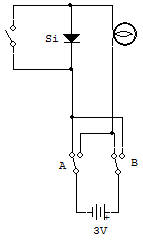
Diode action or Diode Switching

You'll get a chance to look at some of the most simple and basic types of semiconductor circuitry. This section is very important, so follow along closely. The purpose of this project is to demonstrate and study the switching capabilities of a Diode, and in the process show the operation of a DPDT (double pole-double throw) switch hooked up as a three-way switch.
Basic circuit description is as follows:
A 3V Battery is connected through the DPDT switch, which is connected as a polarity reversing switch. The output of the switch is connected through the silicon (Si) Diode to the 3V Lamp.
A Key is wired in parallel with the Diode.
Circuit operation is as follows:
1. Place the Switch in the ON (up) position. The Lamp lights with or without the Key closed. This verifies that the Diode can act like a closed switch.
2. Place the switch in the OFF (down) position. The Lamp will net light unless the Key is closed. This verifies that a Diode can act like an open switch. What makes the Diode operate this way?
The only change which we made to the circuit was to reverse the polarity of the 3V applied-voltage. Therefore it may be concluded that a Diode may conduct current or block the flow of current depending entirely upon the polarity of the circuit current. This is the fundamental and unique property of a Diode.
This basic property of a Diode has been known longer than what electric current is actually composed of. Because of this condition the diode symbol was originally drawn with the arrow pointing in the direction of the supposed direction of unexplained current flow. We now know that electric current is composed of electrons which are moving in the opposite direction of the originally assumed current, called "conventional current".
Actual current (composed of moving electrons) can only flow through a Diode against the arrow head. Diodes are never ideal components so a small amount of voltage is always dropped across the Diode when current is flowing in the forward (conducting) direction.
Also, when reverse-biased (reverse or non-conducting polarity), the Diode allows a small amount of leakage current to flow (microamperes). Silicon Diodes are referred to by the chemical symbol for silicon (Si); Germanium (Ge) Di odes may also be used for switching but are generally not able to handle as much current as Si types can. The polarity-reversing connections used with the DPDT (double pole-double throw) switch are the same as those in 3-way switches used in electrical wiring around the house.
